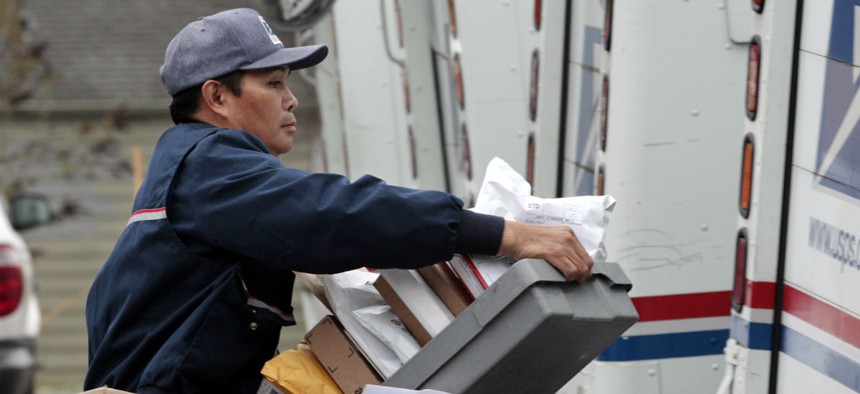
Elaine Thompson/AP file photo
USPS Has Achieved Just a Fraction of Its Projected Savings From Slowing Mail Delivery
Mailing agency rejects proposal to halt future consolidations until it can stabilize productivity.
The U.S. Postal Service is not realizing the savings it projected when it slowed mail delivery and closed facilities, according to a new audit, which also found the mailing agency was struggling to meet its new standards.
USPS said when it virtually eliminated overnight mail while shifting much of its two-day service to a three-day window in 2014 it would save more than $805 million. In a new report, however, the agency’s inspector general identified just 10 percent of that estimate. A large portion of the projected savings -- $679 million -- was slated to come from increased productivity. The IG said USPS could not document any savings from boosting its efficiency.
In fact, the IG found productivity actually declined 4.5 percent in 2015, the year after the new operating window change went into effect. The auditors added productivity has dipped an additional 2.8 percent from January to April 2016.
The Postal Service also said it would save $66 million by eliminating premium pay through shifting employees from night shifts to day shifts, but the IG found no evidence of those savings. The agency reported, however, it has cut $64.3 million in spending through labor and parts attributable to the more lax delivery schedule.
The IG found USPS has realized just 60 percent of its projected savings from cutting outgoing secondary sorting and eliminating less efficient machinery.
As part of its network rationalization strategy, USPS scheduled a two-phase consolidation plan to cut its national footprint. The agency closed 141 facilities in its first phase, while the second phase to shutter an additional 82 plants remains in limbo. Postal management said it has saved $140 million from the closures, but the IG said more than 40 percent of those savings resulted from property sales and lease terminations that took place before the first phase of the plan went into effect.
Postal management overall took issue with the findings in the report, expressing “significant concerns with the report’s content, analysis, and tone.” It specifically said the savings associated with the slowed delivery schedule would be achieved slowly over time. The auditors, however, rejected that premise.
“If the Postal Service did not expect to achieve immediate savings, then it should have identified a plan to recover these savings which clearly documents the amount of savings it expects to achieve and over what period of time it would capture these savings,” the IG wrote. “Despite multiple requests to management for a plan and projections, we did not receive a plan.”
While mail delays spiked in the immediate aftermath of the new operating window, USPS has deployed “quick response teams” to alleviate the problem. After a 51 percent increase in delays from January through September 2015, compared to the same period in fiscal 2014, delayed mail dropped by 54 percent from October 2015 to April 2016. Due to the improvements, and better service scores, the IG ultimately recommended USPS keep the new delivery schedule in place.
The auditors noted, however, that the problem still persists at large facilities. Nearly 30 percent of all delayed mail stemmed from the top 10 facilities in the country. The IG conducted its own, non-statistical sample in which it sent nearly 3,000 pieces of mail from a range of areas. More than one in four of those pieces did not meet the Postal Service’s service standards. First-class mail flats performed the worst, with 44 percent of pieces not reaching their destinations in the designated timeframes.
Postal management derided the survey, emphasizing its results were not statistically significant. Still, the auditors said the delays could negatively impact business.
“Stakeholders, such as members of Congress, commercial mailers, and individual customers, have voiced concerns about the OWC and that delayed mail…is increasing and service is declining,” the IG wrote. “Delayed mail could cause late delivery of time-sensitive mail such as scholarship applications, wedding invitations, birthday cards, or in-home-date-critical consumer advertisements.”
The Postal Service has received criticism for failing to meet its reduced delivery standards and forcing letter carriers out later at night due to the consolidation strategy. Many lawmakers on Capitol Hill have unsuccessfully fought to prevent the agency from loosening standards and closing facilities. As previously reported, the IG noted USPS spending on transportation rose by $130 million in fiscal 2015 due to the new delivery schedule.
The Postal Service agreed to develop targets in its annual budget process to reevaluate projections related to the operational and transportation costs associated with the delivery schedule changes. The agency also agreed to institute a system to track the origin and cause of delayed mail. The agency declined to adopt an IG recommendation to cease further operational changes and facility closures until it developed a strategy to improve productivity.







